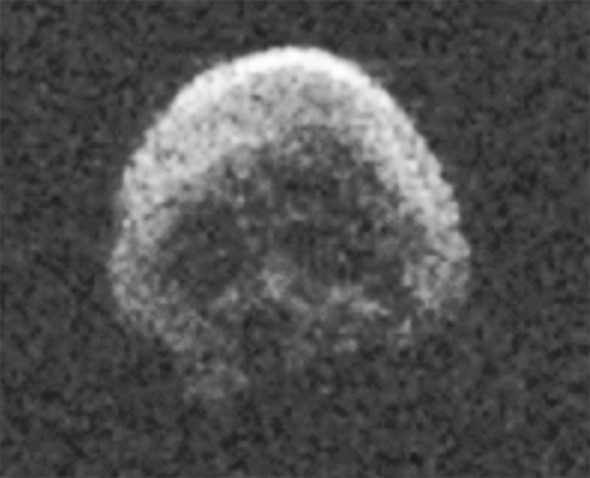Create a free profile to get unlimited access to exclusive videos, sweepstakes, and more!
Halloween Asteroid Is Bigger Than Expected and Also a Giant Dead Comet Skull

Last week, I wrote about a smallish asteroid that would be passing relatively close to—but still well away from—the Earth on Oct. 31. Hey, that’s Saturday! Yup: It’ll pass us at 17:05 UTC, when it will be at closest approach, about 480,000 kilometers (300,000 miles) away, farther than the Moon.
As I mentioned in that earlier article, astronomers were planning on pinging it with radar pulses from the Goldstone radio telescope, and they also used the Arecibo radio ‘scope in Puerto Rico. Those latter observations have been done, and they produced an animation of the asteroid showing it rotating:
The observations indicate it spins roughly once every five hours. It doesn’t appear to have any moons, as many small rocks do. It’s also bigger than expected, about 600 meters across. That happens; it’s hard to get the size from just optical observations. We measure its brightness and distance, and then its size is inferred from that. But a dark rock can be bigger, and a shiny one smaller, with both looking the same brightness.
TB145 was a bit darker than expected, so it’s actually bigger than first thought. It only reflects about 6 percent of the light hitting it, which is pretty dark. That indicates it may be the husk of a dead comet, which tend to be darker on average than asteroids. That would also explain the weird orbit I wrote about last week; it's more short-period cometlike than asteroidlike, really.
Also, I want to point out that the animation above isn’t actually a picture as you normally think of it, because the radio telescope was using radar to map the rock. I’ve explained this before:
Mind you, the radar data is a bit weird. It’s not showing you an actual picture of the asteroid. The vertical axis is showing distance to the asteroid—if there’s a hill you’d see it poke up toward the top, and a crater would be a depression. The horizontal axis, though, is actually the velocity at which the asteroid is spinning. The faster the rock spins, the more smeared out it is left to right; one that doesn’t spin at all would look like a vertical line. I know, it’s weird, but it’s the way this kind of radar observation works.
Emily Lakdawalla at the Planetary Society has a much more detailed explanation.
And one more thing I can help but notice: Given Saturday’s date, how cool is it that the first frame of the animation makes the asteroid look very much like a skull?
Mwuhahahahaha. Happy Halloween!


























